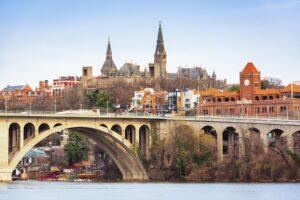Fodor's Expert Review National Museum of African American History and Culture
One of the most popular museums in the nation's capital is perhaps best summed up with a quote by founding director Lonnie Bunch: "The African American experience is the lens through which we understand what it is to be an American." The museum serves as that lens, thanks to more than a dozen exhibitions that display nearly 3,000 historical artifacts, documents, photographs, memorabilia, and media.
The building's structure resembles nothing else on the Mall. The shape of its bronze-color corona was inspired by a Nigerian artist's carving, prominently displayed in one of the galleries. The corona's filigree design was patterned after railings made by enslaved 19th-century craftsmen. The museum's three tiers are hung at the same angle as the Washington Monument's capstone (it makes for a dramatic photo). Powerful quotes from African Americans are strategically placed throughout the space. The museum divides into two parts: 60% is underground, and the remaining 40% is aboveground.... READ MORE
One of the most popular museums in the nation's capital is perhaps best summed up with a quote by founding director Lonnie Bunch: "The African American experience is the lens through which we understand what it is to be an American." The museum serves as that lens, thanks to more than a dozen exhibitions that display nearly 3,000 historical artifacts, documents, photographs, memorabilia, and media.
The building's structure resembles nothing else on the Mall. The shape of its bronze-color corona was inspired by a Nigerian artist's carving, prominently displayed in one of the galleries. The corona's filigree design was patterned after railings made by enslaved 19th-century craftsmen. The museum's three tiers are hung at the same angle as the Washington Monument's capstone (it makes for a dramatic photo). Powerful quotes from African Americans are strategically placed throughout the space. The museum divides into two parts: 60% is underground, and the remaining 40% is aboveground. Lower-level exhibits showcase a somber and wrenching historical timeline from slavery through civil rights. Aboveground galleries celebrate the cultural contributions of African Americans.
To best experience this museum, start at the underground Concourse History Galleries. Here you'll see a portion of a slave ship that broke apart off Cape Town, South Africa, in a 1794 shipwreck that drowned 212 people; a 19th-century, Edisto Island, South Carolina, slave cabin that was occupied until 1980; the original casket of 14-year-old Emmett Till, who was murdered in Mississippi in 1955 for allegedly flirting with a white woman; a railcar with its very different first-class and "colored" sections; and a biplane used to train the Tuskegee Airmen who fought in WWII. Also on the main concourse level is the 350-seat Oprah Winfrey Theater, which hosts musical performances, lectures and discussions, film presentations, and other programming. The Center for African American Media Arts is on the second floor, where visitors can research their families in a genealogy center.
The third- and fourth-floor galleries explore the achievements of African Americans. Highlights include sports memorabilia like Jesse Owens's cleats, Michael Jordan's 1996 jersey, Joe Louis's gloves, Muhammad Ali's robe, Gabby Douglas's leotard, and nine Olympic medals won by Carl Lewis. Other of the collection's many gems include a lobby card from the 1967 movie Guess Who's Coming to Dinner, Louis Armstrong's trumpet, Michael Jackson's sequined jacket, and the jacket and skirt that Marian Anderson wore when she performed a 1939 concert from the Lincoln Memorial.
You must have a timed pass to enter the museum. Same-day timed passes are available online daily beginning at 6:30 am. A limited number of walk-up passes are given out weekdays beginning at 1 pm, but they go fast. Download the NMAAHC mobile app to further enhance your visiting experience.
READ LESS





